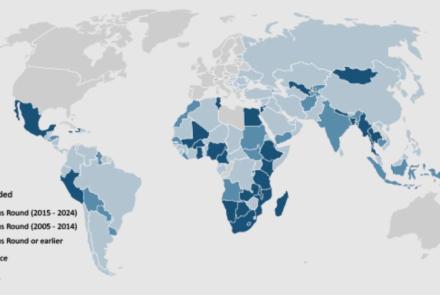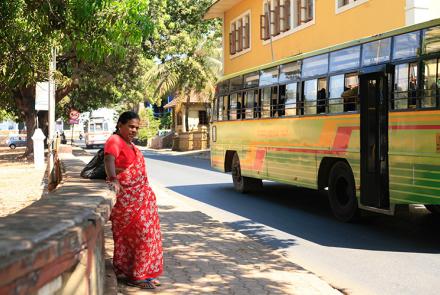Representing women’s voices through phones: Challenges and three solutions
By Fahad Hasin and Divya Nair
On the surface, it appears that mobile phone ownership and use is flourishing in India – but the surface-level statistics don’t tell the full story. Indeed in Indian households, mobile phone ownership is very high: 91% in rural areas and 97% in urban areas, according to the 2019-21 National Family Health Survey (NFHS-5). In addition, the Covid-19 pandemic has driven the increased use of phone surveys over the last two years. With this level of mobile penetration, private companies and government actors are increasingly depending on phone surveys to generate insights – partly because of their lower cost and higher speed.
But there are risks with this approach — namely, ensuring gender representativeness in these surveys and their resulting data. Reaching and talking to women privately has always been challenging in India due to patriarchal social norms. This is further exacerbated in phone interviews due to male gatekeeping of mobile phones. India has one of the highest gender gaps in mobile ownership in the world, and hence there is a worrying gender gap in access to and usage of mobile phones.
Phone use varies by a woman’s location and economic status
According to the NFHS-5, overall, only 54% of women reported having access to a phone that they themselves use, and this is much lower in rural India (47%) than in urban parts (70%). Further, this is correlated with the age of users: while only a third of women aged 15-19 years reported access to a mobile phone that they themselves use, it increases to almost two-thirds for women in their twenties. The number is lesser for older women.
Wealthier women have much higher access to a phone that they use themselves. As per NFHS-5 data, only 33% of women in the lowest wealth quintile reported owning a phone, compared with 79% of women in the highest wealth quintile. Moreover, the overall access to phones among women varies heavily across states: from 39% in Madhya Pradesh and 41% in Chhattisgarh to 91% in Goa, followed by 89% in Sikkim and 87% in Kerala.
Phone survey data may bias gender data that is used to inform policy
Relying on phone surveys can exacerbate the global gender data gap and lead to the persistent absence of women’s and girls’ lives in official statistics. Policy-makers and researchers are left with little insight into the needs, experiences, and progress of half the world’s population without quality gender-disaggregated data on key outcomes. These gaps not only severely under-represent women's voices in household surveys but also create a biased picture by over-representing a sub-group of women based on wealth, geography, etc. For example, in the case of India, rich and urban women from more developed states are more likely to be represented due to patterns of mobile phone accessibility. The specific challenges in reaching women are thus contextual and vary across different regions globally.
Covid- 19 phone surveys shed light on challenges and opportunities when using phones
IDinsight conducted seven rounds of phone interviews on livelihoods, nutrition, and gender-related topics in 2020 during and after the Covid-19 lockdowns among rural households in nine states of India. These ranged from household surveys to within-household surveys (both male and female members were interviewed). These surveys provided rich insight on critical topics. In line with unequal use reported above, in November 2020, less than half (46%) of women respondents reported “daily” use of phones, whereas nearly three-quarters (73%) of men within the same households reported daily phone use.
Fig 1: Reported phone usage rates. Source: COVID-19 KAP survey, November 2020. Error bars denote 95% CI.
[Note: This figure was originally published in our article in BMJ Health journal]
We analysed the metadata from the phone surveys to understand the challenges and solutions to reaching women on phones. We found that when a household is cold-called, around 65% of the time, a male member picks up the phone — since men tend to manage the phone or carry phones to their workplace. In addition to this, it was difficult to get a successful phone pass from the person who picked up to the target respondent during a given call (~10% success rate). This was regardless of the former party’s gender, and often because both genders were not co-located at the time of the call. As a result, women were more likely to be under-represented in phone surveys where a household is cold-called. We suggest three ways to mitigate this challenge based on our experience in India.
Fig 2: Gender of respondent who first answered the phone. Surveys featured in figure are those for which the gender of respondent who first picked up was recorded. Error bars denote 95% CI.
[Note: This figure was originally published in our article in BMJ Health journal]
First, having women surveyors conduct interviews increased the chances of completing surveys with women by almost 14 percentage points in our surveys. Further, the refusal rate (i.e., non-consent rate) was twice as high (12%) for male enumerators as it was for female enumerators (6.1%) for a survey that included sensitive topics such as reproductive health, childbirth, and breastfeeding. This is likely because it is sometimes culturally inappropriate for a woman to speak to a man other than her family members.
This calls for a structural shift in the survey industry that is currently male-dominated. Our experience of large-scale surveys with all-women enumerators in Rajasthan can offer guidance to organisations. We also conducted a survey of surveyors to understand the specific problems faced by female surveyors in India and how to address them. We found that female surveyors face more challenges regarding transportation and safety; most also felt that male surveyors are recognised more for their work. Investments and organisational commitment are required to increase the female surveyor pool. This is relevant for in-person surveys as well, particularly for sensitive questionnaires.
Second, scheduling time for appointments and call-backs help. Women disproportionately bear the burden of domestic work and face idiosyncratic circumstances. Calling them back at their preferred time takes that into account. Female representation was higher (43%) in surveys when we made appointments versus surveys in which we targeted women but did not make appointments if we failed to reach them during our first household contact (21%–38%). Generally, cracking the right timing can also increase the chances of reaching women. This could depend on agriculture season, women’s work schedule, domestic work activities, etc. Survey teams should be open to experimenting with different time slots.
Third, building trust is key. In phone surveys, there is a context of suspicion as one often does not know who is on the other side and cannot see them. Disconnecting a call is easier than refusing a person at the doorstep. Hence, noting where the surveyor got the respondent’s number and mentioning contact with trusted institutions where relevant (such as local NGOs, etc.) can be helpful. Reminding respondents of earlier touch-points is important if it is a follow-up survey.
There is no silver bullet here, and we acknowledge the complex layers of gaps in reach and access. While these steps can each contribute to increasing the chances of reaching women, they do not completely ‘solve’ the problem. Further, these insights are highly contextual. For example, women surveyors did not make a significant difference in reaching women in some of our surveys in Kenya and Uganda (where gender gaps in phone use/access were lower, to begin with).
Finally, in addition to surveys, mobile phones are increasingly being used for other programmes, including those related to financial inclusion, providing behaviour change messages. We hope that this article serves as a note of caution, and programmes designers factor in the underlying potential exclusions and actively address them. There has been an increasing realisation of the gendered digital divide in the development community. For example, there have been some interventions involving free mobile phone giveaways to women. The early evidence, however, shows that the constraint goes beyond mere access to phone. This is an important, multifaceted issue that also requires addressing issues around digital literacy, associated recurring costs, and unfavourable social norms.
*Photo from IHDS archives

- Log in to post comments




